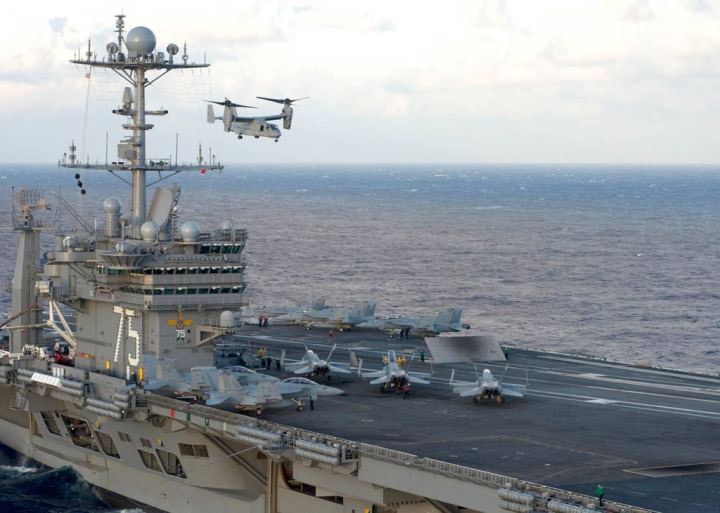Navy Decides to Buy V-22 Ospreys for Carrier Delivery
Posted on
The Navy will buy V-22 Osprey tiltrotors to replace its aging C-2A Greyhound turboprop aircraft in flying carrier on board delivery (COD) missions. Breaking Defense obtained a Jan. 5 memo, signed by Secretary of the Navy Ray Mabus, Chief of Naval Operations Adm. Jonathan Greenert, and Marine Corps Commandant Gen. Joseph Dunford. It stipulates that the Navy will buy four V-22s each year from fiscal 2018 to 2020.
The MOU marks a major triumph for the Naval Air Systems Command V-22 program office, the Marine Corps and other Osprey advocates, who have argued for years that the Navy should replace its aging conventional take off C-2As with vertical take off and landing V-22s.
“The Navy is responsible for modifying these V-22s into an HV-22 configuration for the COD mission,” the MOU states. “The parties agree that subsequent documents will provide details on the concept of operations and milestones. A memorandum of agreement will detail reimbursable Marine Corps support for the Navy’s HV-22 transition, which includes training and potential deployment of Marine MV-22 aircraft and personnel to support COD requirements.”
The Navy-Marine Corps agreement must be ratified in the next defense budget and by Congress. It also depends in part on a prospective third V-22 multiyear procurement contract that would begin in fiscal year 2018. C-2A maker Northrop Grumman has proposed building a modernized version incorporating features of the E-2D Advanced Hawkeye tactical early warning aircraft.
The twin-engine turboprop C-2As carry cargo, mail and passengers between aircraft carriers and shore — a mission called COD for “carrier on-board delivery.” The first Greyhound prototypes flew in 1964.The Osprey, built in a 50-50 partnership by Bell Helicopter Textron Inc. and Boeing Co. and in service with the Marine Corps since 2007 and the Air Force since 2009, tilts two large wingtip rotors up to take off and land vertically and forward to fly like a turboprop airplane, giving it far greater speed and range than conventional helicopters.
The MOU signed by Mabus, Greenert and Dunford marks a milestone in the history of the revolutionary V-22, which began in the early 1980s at the behest of Navy Secretary John Lehman but took a quarter century to get into service. The Navy was originally supposed to buy as many as 380 Ospreys for search and rescue and antisubmarine warfare missions, but after Lehman left office, the service cut its paper requirement for V-22s to 48. The Marines are acquiring 360 Ospreys and the Air Force Special Operations Command another 50. As of March, the program office reported that 257 of a planned 460 Ospreys, including two for research, development, test and evaluation, had been acquired. Under the latest multiyear contract, which ends in fiscal 2017, the “flyaway cost” for each Osprey is about $68 million.
Until the past couple of years, Navy leaders had shown little interest in actually buying their planned 48 Ospreys. But in 2011, the Marine Corps began qualifying its MV-22s for carrier landings, and a six-day “military utility assessment” conducted last summer off the coast of Florida, in which V-22s carried passengers and cargo to and from the USS Harry S Truman (CVN 75), found that: “The V-22 demonstrated an effective, flexible, and safe capability to conduct the COD mission with no modifications and no adverse impact to cyclic flight operations.”
Navy and Marine Corps commanders of Amphibious Ready Groups carrying Marine Expeditionary Units, meanwhile, have found that using the Osprey to carry passengers and cargo among the standard ARG complement of three vessels enables the ships to conduct separate operations at ranges far greater than possible when CH-46 Sea Knight helicopters were their primary supply aircraft.
Under the Jan. 5 MOU, the first dozen HV-22s would be taken from what would have been the Marine Corps share of V-22s built in fiscal 2018-20 under the prospective third multiyear contract. Those first Navy V-22s will be replaced in the Marine Corps inventory in fiscal years 2021, 2022, and 2023 with a dozen Ospreys “that would have been allocated to the Navy,” the memo provides.
Subscribe to our newsletter
Promotions, new products and sales. Directly to your inbox.

